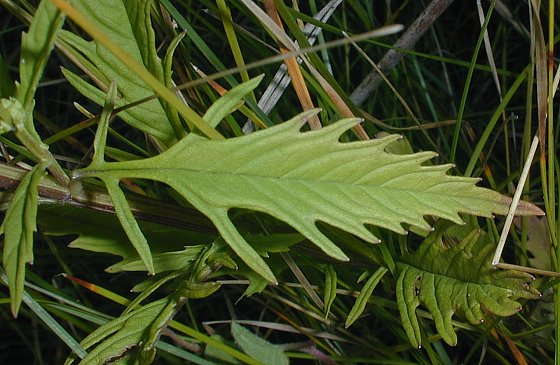Infrequent to frequent throughout the state. It is found in wet and moist ground in all kinds of habitats. This species was reported by some of our early authors as Lycopus europaeus L. when some of our manuals did not separate this species from the European plant. All of our Indiana reports for the European species should be referred to Lycopus americanus. [Variety longii is more densely pubescent, the hairs being long, spreading, and multicellular.] This variety is not well marked on account of a lineal series of intermediates, but is amply distinct in the extremes. In Indiana it is restricted mostly to our northern counties where it grows in habitats similar to those of the species but usually in slightly wetter situations
Duration: Perennial
Nativity: Native
Lifeform: Forb/Herb
General: Non-aromatic perennial herb, 25-50 cm tall, from stolons; stems square in cross section, erect, and unbranched or branching low on the plant; herbage glabrous or hairy at the nodes.
Leaves: Opposite, on winged petioles 4-9 mm long; blades broadly to narrowly elliptic in outline, 3-8 cm long and 2-3 cm wide, with a long-tapering base and margins that are pectinately lobed near the base and lobed or coarsely toothed above that; surfaces dotted with small punctate glands.
Flowers: White, in dense clusters, 5-7 mm wide, at leaf axils; calyx 2-3 mm long, topped with 5 narrow spine-tipped teeth; corolla white, 3-4 mm long, bugle-shaped and topped with 4 or 5 rounded lobes.
Fruits: Nutlets 4 per flower, a little longer than the calyx tube, with corky margin forming a crest at the apex.
Ecology: Found in riparian or other moist to wet areas within pinyon-juniper, ponderosa pine, and Douglas fir communities, from 5,000-7,500 ft in the Southwest (1524-2286 m); flowers June-July.
Distribution: Throughout the US; s CAN; and n MEX.
Notes: This often stoloniferous species of moist ground resembles a mint (Mentha spp.) but does not smell minty. Flowers are inconspicuous in little clusters at the base of leaves. The white petals are about the same length as the sepals so are not particularly visible. Quite similar to L. asper in appearance and habitat; to distinguish betwen the species, focus on the leaves. L. asper has sessile leaves with shallowly toothed margins. In particular the leaves closer to the bottom of the plant are truly sessile, while those near the top may have short, broadly winged petioles up to 2 mm long. L. americanus has leaves with winged petioles 4-9 mm long, and the margins of the leaves are pectinately lobed near the base, and often irregularly toothed or lobed closer to the leaf tip.
Ethnobotany: The whole plant is used as an astringent, hypoglycaemic, mild narcotic and mild sedative. It also slows and strengthens heart contractions.
Etymology: Lycopus comes from the Greek lycos, wolf, and pous, foot, or wolf-footed; americanus means of or from America.
Editor: AHazelton 2017
Rhizomes elongate, without tubers; lvs glandular- punctate and usually glabrous (or scabrous above) except along the veins beneath, where provided with short hairs only 0.1-1.5 mm, the blade lanceolate or narrowly oblong to nearly linear, 3-8 cm, tapering to a short petiole or narrow, subpetiolar base, coarsely and irregularly incised-toothed or subpinnatisect, the lower teeth the larger; bracts lanceolate and about equaling the cal, avg 3 mm; cal 2-3.3 mm, its 5 lobes narrow, firm, slenderly subulate-pointed, surpassing the nutlets; cor 4-lobed, the upper lobe broader and notched; anthers 0.25-0.5 mm; nutlets 1.0-1.4 נ0.7-1.0 mm, the outer apical margin smooth and broadly rounded, the corky lateral ridges confluent around the tip, the inner angle much shorter than the outer ones, so that the center of the set of nutlets is depressed; 2n=22. Our most abundant sp.; Nf. and Que. to B.C., s. to Fla. and Calif.
Gleason, Henry A. & Cronquist, Arthur J. 1991. Manual of vascular plants of northeastern United States and adjacent Canada. lxxv + 910 pp.
©The New York Botanical Garden. All rights reserved. Used by permission.







